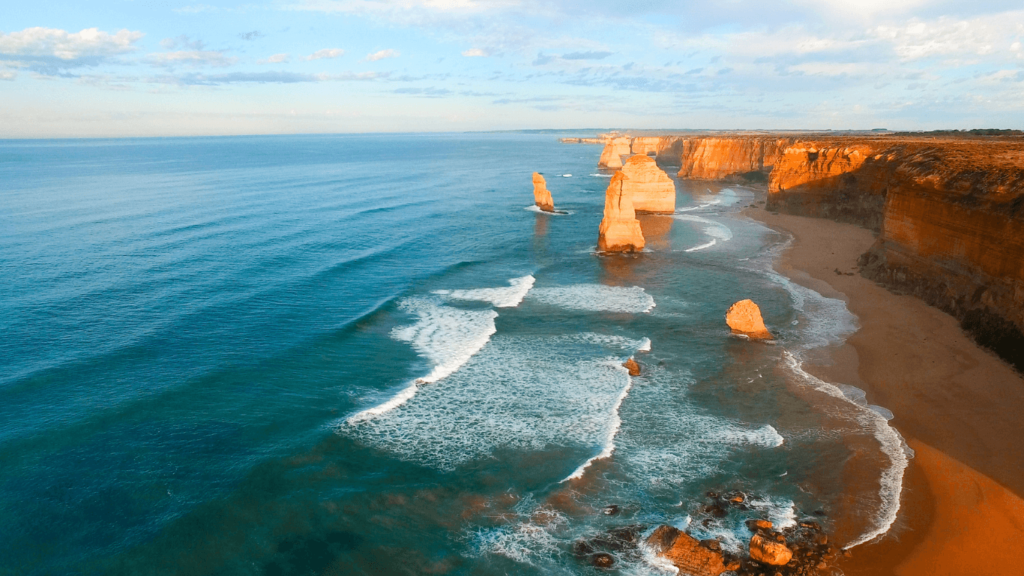Strength Training, Outdoor Fitness
Pedaling Paradise: Exploring Australia’s Great Ocean Road By Bike

The Ultimate Guide to Cycling Great Ocean Road, Victoria, Australia
The Scenic Route That Will Take Your Breath Away
If you’re dreaming of a cycling adventure with jaw-dropping views, the Great Ocean Road in Victoria, Australia is the place to be. This 243-kilometer coastal road stretches from Torquay to Allansford and is considered one of the world’s most iconic scenic drives. But why just drive when you can cycle?
Biking along this route allows you to fully immerse yourself in its natural beauty while giving you an invigorating workout. While primarily known for its stunning ocean views, the Great Ocean Road also takes you through charming towns and unique attractions.
You’ll pass by quaint seaside villages and historic landmarks as well as lush rainforests and sprawling farmlands. With so much variety, each day’s ride feels like a new adventure.
Why Cycling is a Great Way to Explore the Area
Cycling allows for a deeper connection with your surroundings than driving ever could. You can stop whenever and wherever you want to take in the sights or snap some photos. The slower pace also lets you fully appreciate the landscape and wildlife that call this area home.
In addition to being environmentally friendly, cycling also offers health benefits that will make your trip even more enjoyable. The exercise releases endorphins that boost your mood and energy levels.
Plus, there’s nothing quite like that feeling of accomplishment after conquering a tough hill climb! Not only is cycling fun and good for you, it’s also an activity that can be enjoyed by people of all ages and fitness levels.
Whether you’re an experienced cyclist or just starting out on two wheels, there are routes along the Great Ocean Road that will suit your needs. So grab your helmet and get ready for an unforgettable journey along one of Australia’s most beloved roads.
Table of Contents
Planning Your Trip
The Best Time to Visit for Cycling
Before hopping on your bike and heading out, it’s essential to choose the right time of year. The Great Ocean Road can be unpredictable when it comes to weather, so it’s best to avoid visiting during the winter months between June and August, as the weather can be cold and wet.
The best time to visit for cycling is during the summer months between December and February when temperatures are mild, and rainfall is low. However, keep in mind that this is also peak tourist season, so accommodation options may fill up quickly.
If you’re looking for a quieter experience with fewer crowds, consider visiting during autumn or spring. These shoulder seasons offer cooler temperatures but still plenty of sunshine.
Choosing the Right Bike and Gear
Choosing the right bike is crucial for a comfortable ride along Great Ocean Road. You’ll want a sturdy bike with enough gears to handle any hills or inclines you may encounter along your route. A road bike is an excellent option for those looking to cover more distance at higher speeds while a hybrid or mountain bike may be better suited for those looking for more stability on uneven terrain.
In addition to your bike choice, consider investing in quality cycling gear such as padded shorts, gloves, helmets, and sunglasses. These items will help keep you comfortable during long rides and protect you from the sun’s harsh rays.
Accommodation Options Along the Route
There are plenty of accommodation options available along Great Ocean Road catering to all budgets and preferences. If you’re looking for a luxurious experience after a long day of cycling, there are several upscale resorts located along the coast with stunning ocean views. For budget-friendly options, there are campsites located throughout Great Otway National Park that offer affordable camping options with access to hiking trails and other outdoor activities.
If you prefer a more authentic experience, consider staying in a small town along the route such as Lorne or Apollo Bay. These towns offer cozy bed and breakfast options, local cafes, and restaurants, providing a glimpse into the relaxed coastal lifestyle.

Cycling the Great Ocean Road
Starting Point and Direction
So, you have planned your trip to cycle the Great Ocean Road, but where do you start? The most popular starting point is Torquay, a small coastal town located just over an hour’s drive from Melbourne. Starting from Torquay allows you to experience one of the most beautiful sections of the road – Bells Beach.
If you prefer a shorter route, then starting from Lorne is also an option. From Lorne, you can head towards the Otways National Park and explore some of the rainforest trails.
Highlights of the Route
One of the top highlights along Great Ocean Road is undoubtedly the Twelve Apostles. These towering limestone stacks are a must-see attraction and can be seen from several vantage points along the road. Another highlight is Bells Beach – famous for its surf culture and annual Rip Curl Pro competition.
Be sure to take your time on this section of the road as it offers breathtaking views of rugged cliffs, crystal clear waters, and stunning beaches. Other notable highlights include Loch Ard Gorge – named after a shipwreck that occurred here in 1878 – which showcases some impressive rock formations; The Grotto – a natural sinkhole in limestone cliffs with turquoise blue water; and London Bridge – another stunning sea stack formation that has been eroded by wind and waves over time.
Challenges and Tips for Navigating the Road
Cycling Great Ocean Road can be quite challenging due to its hilly terrain, wind gusts (especially during winter), narrow roads with little shoulder space, uneven surfaces in some areas, and occasional traffic congestion during peak seasons. To make your cycling experience more enjoyable, it’s important to carry enough water, snacks or energy bars for long rides between towns or cafes. Also, make sure that you wear comfortable cycling gear, including a helmet and padded shorts.
If you’re cycling during winter or cooler months, don’t forget to carry warm clothes and rain gear. It’s also crucial to follow road rules and be aware of surrounding traffic at all times.
The Great Ocean Road is a popular tourist destination, so expect traffic congestion during peak seasons. It’s advisable to cycle early in the morning or late in the afternoon when traffic is lighter.
Overall, cycling Great Ocean Road is a unique experience that offers stunning coastal scenery, challenging terrain for cyclists, and rich cultural history. So let’s get on our bikes and explore this breathtaking region of Victoria!
Local Culture and History
Indigenous history and cultural sites in the area
The Great Ocean Road is not only a scenic route, but it’s also rich in Indigenous history and culture. The area has been home to the Gunditjmara people for thousands of years, and they have left behind significant cultural landmarks.
One of the most notable is the Budj Bim Cultural Landscape, which was recently added to UNESCO’s World Heritage List. This site features an extensive network of aquaculture systems that were developed by the Gunditjmara people to harvest eels.
Other Indigenous sites along the Great Ocean Road include rock art galleries and burial grounds. The Worn Gundidj Aboriginal Cooperative offers guided tours that provide insight into the Indigenous culture and connection to the land.
European settlement history and landmarks
The Great Ocean Road was built as a memorial for Australian soldiers who lost their lives during World War I. As such, it holds significant historical significance for Australians. Along with Indigenous heritage sites, there are also several European settlement landmarks scattered along the road. One example is Cape Otway Lightstation, which marks Australia’s most important lighthouse site.
It was built in 1848 and played a crucial role in guiding ships safely along this treacherous coastline. Another landmark worth visiting is Port Fairy, a charming fishing village with over 50 National Trust-classified buildings from European settlement times.
Local food and drink options
Exploring local cuisine can be one of the best parts of any travel experience, especially when it comes to regional specialties. The Great Ocean Road region is famous for its seafood offerings such as fish & chips or freshly caught crayfish served straight off fishing boats. For those looking for more sophisticated culinary delights, there are restaurants like La Bimba in Apollo Bay or Brae just outside Birregurra, which is routinely ranked as one of Australia’s top restaurants.
For those looking to sample local beverages, there are several craft breweries and wineries along the route. One example is Prickly Moses Brewery in Otway, which specializes in craft beers brewed on-site with locally sourced ingredients.

Wildlife Encounters
Common animals to spot along the road (e.g., koalas, kangaroos)
Great Ocean Road is home to a diverse range of wildlife. One of the most iconic animals to spot on your cycling adventure is the koala.
These cute and cuddly creatures can be seen napping in gum trees along the road. Keep an eye out for their distinctive grey fur and round ears.
It’s important to remember that koalas are wild animals and should not be approached or disturbed. Enjoy observing them from a distance and make sure to follow any posted signs or guidelines.
Another animal commonly spotted along the Great Ocean Road is kangaroo. These fascinating creatures can often be seen grazing in open fields or hopping through nearby bushland.
If you’re lucky, you may even spot a wallaby or two! Remember that kangaroos are also wild animals and should not be approached, especially if they have young joeys with them.
Tips for safely interacting with wildlife
While spotting wildlife on your cycling trip can be an exciting experience, it’s important to remember to practice safe and respectful interactions with these creatures. Here are some tips: – Always keep a safe distance: Never approach or touch wild animals, as this can cause stress and harm.
– Observe from a distance: Use binoculars or cameras with zoom lenses to observe animals from afar. – Follow posted guidelines: Many areas along Great Ocean Road have specific rules about interacting with wildlife.
Make sure to read any posted signs or guidelines before approaching. – Respect their space: If you come across an animal on a walking trail or path, give them plenty of space to move around freely.
– Do not feed them: Feeding wildlife can disrupt their natural diet and behavior patterns. By following these simple tips, you’ll ensure both your safety and the safety of the wildlife along Great Ocean Road.
Off-the-Beaten-Path Adventures
Hidden Gems along the Road
While cycling along the Great Ocean Road, be sure to keep an eye out for the hidden gems that lie off the beaten path. One such gem is Blanket Bay, a secluded beach that can only be accessed by foot.
Pack a picnic lunch and enjoy the peace and tranquility of this beautiful spot while taking in the stunning views of the ocean. Another hidden gem worth visiting is Stevenson Falls, located in Great Otway National Park.
This waterfall is easily accessible from the road and offers a refreshing break from cycling. Take a short hike to reach the base of the waterfall and feel the mist on your face.
For those looking for something a bit more challenging, there’s also The Redwoods Mountain Bike Park. Located near Colac, this park offers trails suitable for riders of all levels, with unique redwood trees lining some of its paths.
Unique Activities to Try in Nearby Towns
While cycling along Great Ocean Road, take some time to explore nearby towns and try some unique activities they have to offer. In Apollo Bay, you can try your hand at sea kayaking or stand-up paddleboarding.
These activities offer an up-close view of marine life such as seals and dolphins. If you’re craving something sweet, make sure to stop by Timboon Fine Ice Cream in Timboon Village.
This charming town is also home to Timboon Railway Shed Distillery where you can sample locally distilled whiskey. For those interested in history, Port Fairy boasts many well-preserved historic buildings including cottages from early European settlement days as well as grander buildings like banks and post offices which date back over 100 years ago.
The port was one of Victoria’s earliest settlements where whalers would frequent before being converted into a port where many goods were transported. Take a walk around and soak up the history of this charming town.
Sustainability Practices
Leave No Trace
One of the most important things you can do to minimize your impact on the environment while cycling Great Ocean Road is to practice Leave No Trace principles. This means packing out all of your garbage, avoiding disturbing natural features or wildlife, and using established trails and campsites.
When you’re traveling by bike, it’s especially important to be mindful of the impact you’re having on the environment. Take care not to leave any tire tracks in sensitive areas, and avoid disturbing plants or animals along the way.
Bike Maintenance
Another way to reduce your impact on the environment while cycling is to maintain your bike properly. Keeping your tires inflated and making sure your brakes are in good working order will help you avoid skidding or dragging on roads or trails, which can cause damage over time.
Regularly cleaning and lubing your chain will also help prevent it from grinding down too quickly. These small actions may seem inconsequential, but they add up over time.
Supporting Local Sustainability
Buy Local
One way to support local sustainability efforts while cycling Great Ocean Road is to buy local products whenever possible. This may include stopping at roadside stands for fresh produce or visiting small businesses that source their materials locally. By supporting these types of businesses, you’ll be helping keep money within the community and reducing carbon emissions associated with shipping goods long distances.
Eco-Friendly Accommodation
Consider staying at eco-friendly accommodation options along Great Ocean Road that prioritize sustainability practices like recycling programs or renewable energy sources. There are many options available for travelers who want to stay somewhere that aligns with their values – from camping in nature reserves to staying at a bed-and-breakfast run by a family committed to sustainable living practices.
Overall, there are many ways to be mindful of your impact on the environment while cycling Great Ocean Road. By practicing Leave No Trace principles, maintaining your bike properly, buying local, and choosing eco-friendly accommodation options, you can minimize your footprint and make a positive impact on the local community and ecosystem.
Conclusion
Cycling Great Ocean Road is truly a must-do experience for anyone who enjoys nature, adventure, and the thrill of exploration. From the stunning coastal scenery and pristine beaches to the rich cultural history and abundant wildlife, there is something for everyone along this iconic route.
One of the greatest advantages of cycling the Great Ocean Road is the unparalleled access it provides to some of Australia’s most breathtaking natural wonders. From the towering cliffs and rock formations at Twelve Apostles to the lush rainforests surrounding Otway National Park, there are countless opportunities to immerse yourself in nature and experience its beauty up close.
But beyond its scenic splendor, what makes cycling Great Ocean Road truly special is the sense of adventure that comes with exploring this iconic route on two wheels. With challenging hills, winding switchbacks, and long stretches of open road, every day brings new challenges and rewards.
Whether you’re an experienced cyclist or just starting out, there’s no better way to test your limits and push yourself than by cycling Great Ocean Road. So if you’re looking for an unforgettable adventure that combines breathtaking scenery with thrilling physical challenges, look no further than Great Ocean Road cycling.
Whether you plan to tackle the entire 243-kilometer route or just a portion of it, you’re sure to come away with memories that will last a lifetime. So get on your bike and start exploring today!
Want more breathtaking views and destinations? Check out the Pacific Coast Highway. You’ll thank me later. 🙂



